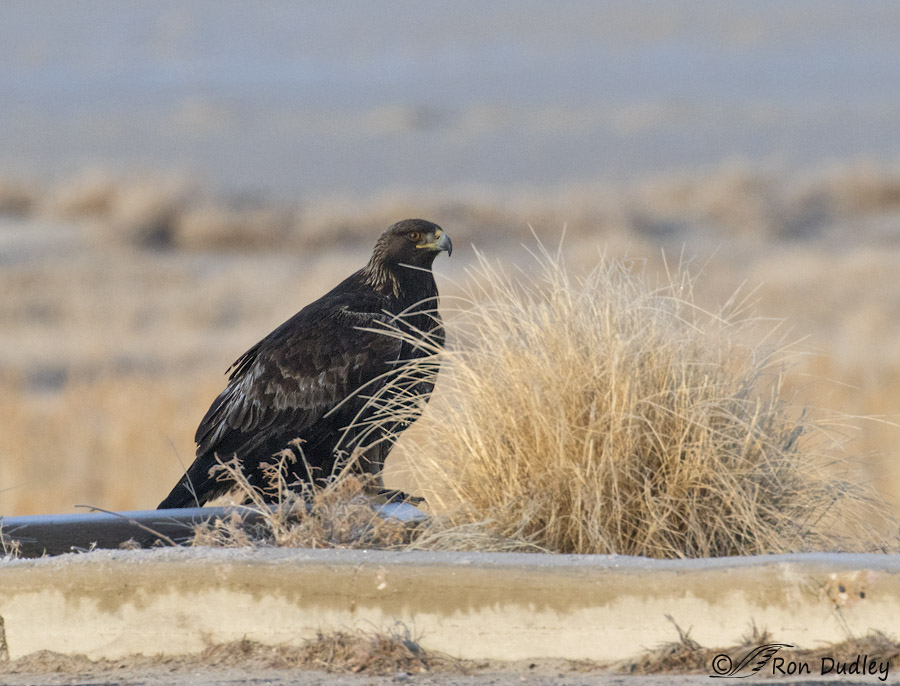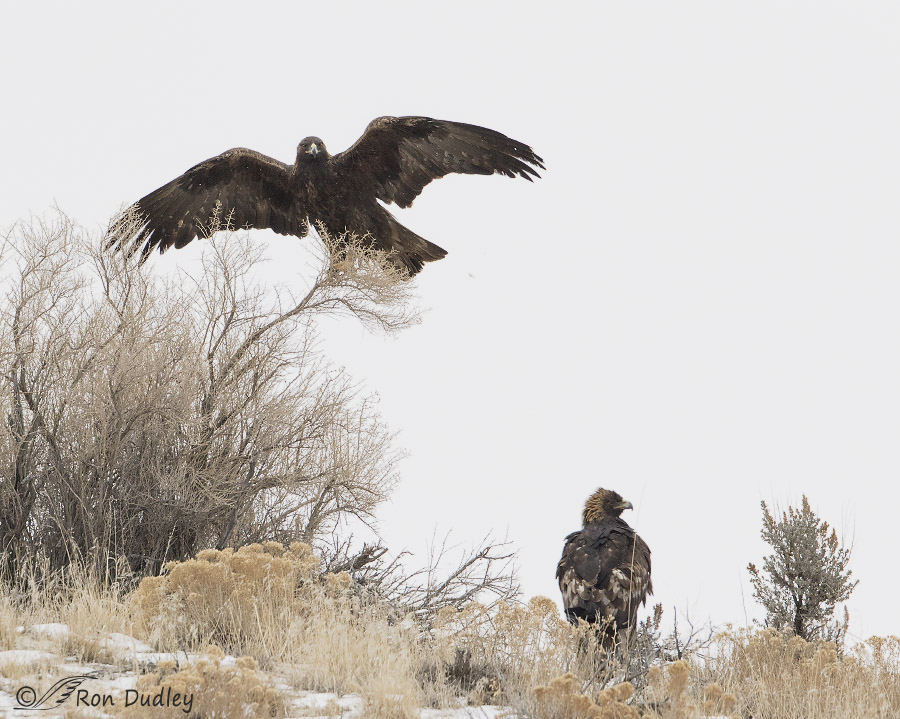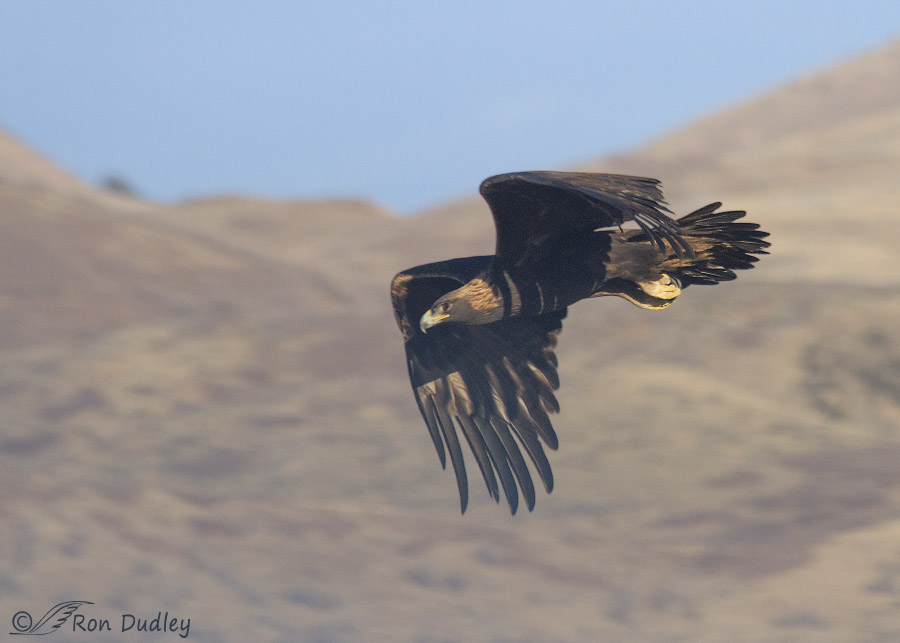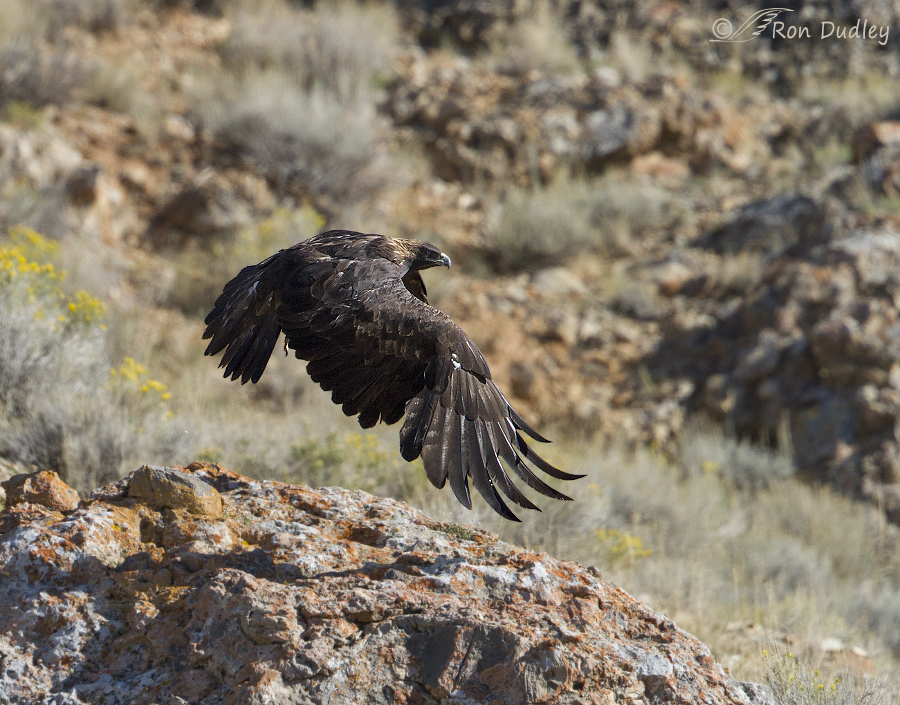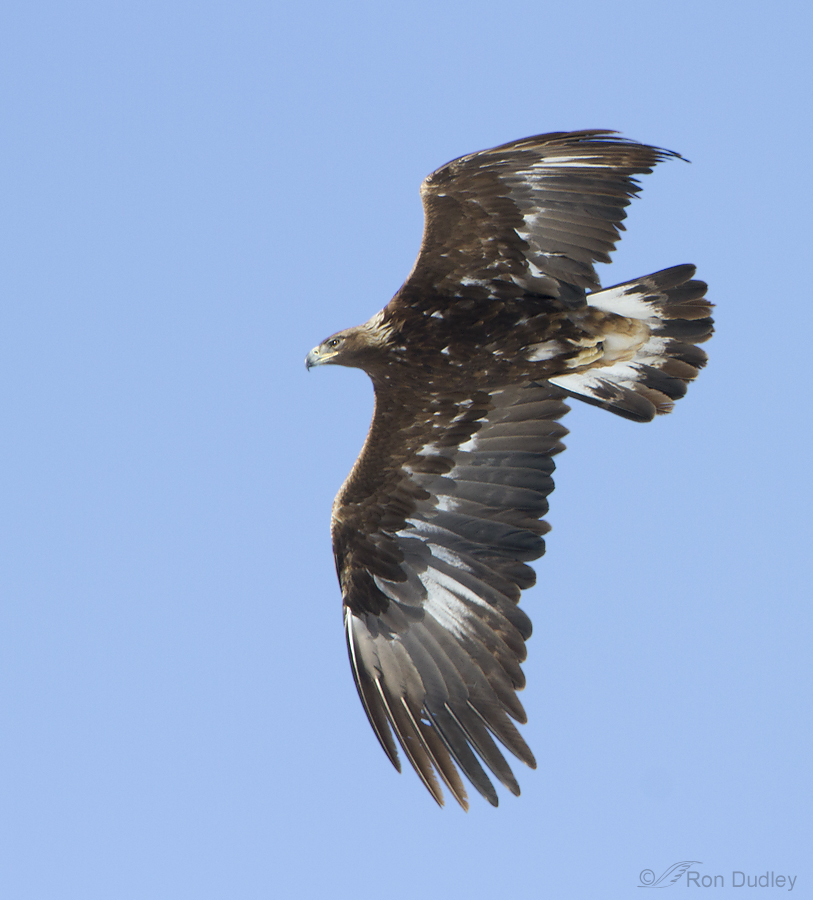Tag: golden eagle
Two Golden Eagles On Antelope Island
Golden Eagle In Flight (no wires this time)
Golden Eagle – Out, Damn’d Wires, Out!
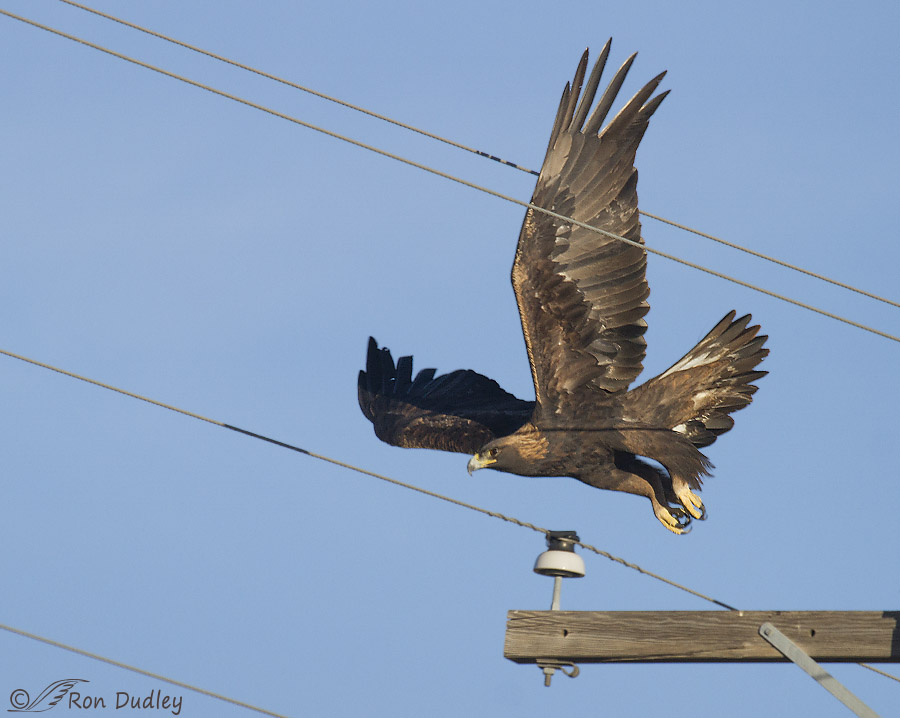
I have a small list of personal nemesis species but if forced to choose the top contender it would have to be the shy and elusive Golden Eagle. I’d estimate that I get a reasonable chance with one of these birds about two times per year and every time something goes wrong that prevents me from getting the photos I covet so much. Two mornings ago it was those ever-pesky power lines.
Golden Eagle – My #1 Nemesis Bird. The Curse Continues But Twice I Almost Succeeded
West Desert Red-tail In Flight
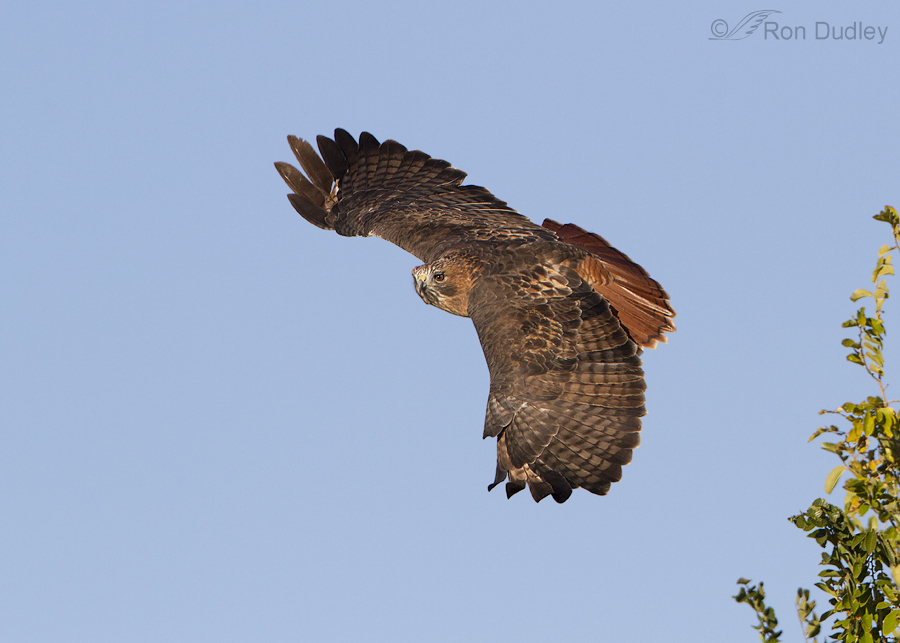
Last month we ventured out into the west desert in an attempt to locate and photograph buteos and Golden Eagles. With the exception of one adult Red-tailed Hawk and a (mostly uncooperative) Golden Eagle who let us get close it was largely a frustrating morning.
The red-tail was perched in a tree that was swaying in the wind and it was quite entertaining to watch it rockin’ and rollin’ as it attempted to remain stable on its unstable perch.
Golden Eagle In Flight
A Guide To Aging Bald Eagles
As we go into prime “eagle watching” season here in northern Utah I thought it might be timely to present a guide that would be helpful in aging Bald Eagles as they progress through the 5-6 year process of becoming adults. Many of these younger birds are mistakenly identified as Golden Eagles by the general public. Eagles that have not reached the adult stage are referred to as immature, juveniles or sub-adults. Plumage stages are highly variable, depending on molt sequence, age and timing so other factors like iris and beak color are also taken into account when estimating age. Eyes gradually change from dark brown to yellow while the beak goes from blackish-gray to yellow. 1/4000, f/8, ISO 500, 500 f/4, not baited, set up or called in The adult Bald Eagle is unmistakable with its distinctive bright white head and tail contrasting with the dark brown body and wings. 1/200, f/6.3, ISO 800, 500 f/4, 1.4 tc, not baited, set up or called in But juveniles present very differently than adults, especially in the early stages of development. This very young bird is barely fledged and was still hanging around its nest in sw Montana. Notice that the plumage is dark brown throughout, though they may have some white or pale mottling at this stage – especially on the underparts. Both eye and beak are very dark. 1/2000, f/6.3, ISO 500, 500 f/4, 1.4 tc, not baited, set up or called in This is a first year bird during winter. 1/800, f/8, ISO 500, 500 f/4, natural light,…
Birds Dealing With Snow And Cold
Birds use a variety of tactics to deal with the harsh conditions presented by an unusually cold and snowy winter. Some are more effective than others. I thought it might be interesting to see a few of them that I’ve been able to photograph in the last several weeks. My usual disclaimer for posts relating to behaviors; many of these images are technically lacking but I think they do illustrate some of the conditions these birds are having to cope with. 1/2500, f/6.3, ISO 640, 500 f/4, 1.4 tc, natural light After a fresh snow, the food source for many small birds is largely hidden and unavailable without some extraordinary measures. This juvenile White-crowned Sparrow, and others in the flock, were flitting from one snow-covered perch to another in an obvious attempt at knocking the snow off so they could get to the seeds underneath. Here you can see the snow falling away and immediately afterward the sparrow fed on the uncovered seeds. 1/2500, f/7.1, ISO 500, 500 f/4, 1.4 tc, natural light, not baited, set up or called in When it gets very cold most water sources freeze up completely which makes fish largely inacessable to Bald Eagles so many of them turn to scavenging as their primary food source. But this species adapted very well to scavenging eons ago which is one of the reasons Ben Franklin looked in disfavor at the proposal to make the Bald Eagle our national bird. 1/1000, f/5.6, ISO 640, 500 f/4, 1.4 tc, natural light, not baited, set up or…
A Recent Potpourri Of Birds From Antelope Island
Antelope Island always has an interesting mix of birds for the photographer and birder. During the winter months raptors are one of the primary attractions for me but soon after the cold months are over they begin to thin out and the migrating spring birds begin to appear. The last several weeks have been in transition with fewer raptors but many migrating species are beginning to show up – in addition to the many year-round residents on the island. With this post I thought I’d present a few shots from the past week or so as a small representation of some of the common birds right now. 1/2500, f/6.3, ISO 500, 500 f/4, 1.4 tc Black-billed Magpies are year-round residents of the island and they’re in a nesting frenzy right now which allows for some interesting opportunities for the photographer. This bird is landing on a bush very near its nest. 1/1250, f/7.1, ISO 500, 500 f/4 Springtime is my favorite season to photograph Chukars because they’re all dolled out in fresh plumage and they’re very approachable when they’re calling from rocks. For much of the rest of the year they spend their time scurrying around in the vegetation and it’s quite difficult to get a clean shot. This one was calling with a lot of enthusiasm! 1/3200, f/5.6, ISO 500, 500 f/4, 1.4 tc Some of the Loggerhead Shrikes also remain on the island year-round but their numbers increase noticeably in spring. 1/1000, f/6.3, ISO 640, 500 f/4, 1.4 tc It’s always a treat when the Long-billed Curlews return to…
Golden Eagle In The Wind And Cold
It was a brutal morning on the island yesterday with 25 degree F temps, winds of over 4o mph, fresh snow and icy roads. It was eerie-sounding to drive on the roads as the night before the snow had partially melted and then froze hard into a bumpy, icy and noisy sheet. I knew there’d be no sneaking up on any birds because my pickup sounded like a freight train approaching on that crunchy ice. The gulls were just about the only birds out and about. They seemed to enjoy soaring in the wind but when they’d settle into the water they chose areas partially protected from the wind, like this cove where the causeway meets the island. The night before the wind had pasted snow onto the sides of the bison and then it froze to their hides. Some of them were mostly covered with ice. This image and the next one should give regular readers of my blog some idea of why I occasionally grumble about all the dried sunflowers we have this year. They make it virtually impossible to get a clear shot of any subject on the ground. 1/4000, f/5.6, ISO 640, 500 f/4, 1.4 tc We had just about resigned ourselves to being essentially “skunked” for the morning when we spotted this Golden Eagle not too far from the road. It was feeding on what I assume was a jack-rabbit (it was relatively large and there are lots of them in the area) but of course it was buried in the sunflowers and I…
Golden Eagle – Some Progress On A Nemesis
Anyone who follows this blog knows that I have a penchant for raptors and over the last 6 years of photographing them I can count on one hand the number of good opportunities I’ve had with Golden Eagles. I had another chance at one yesterday on Antelope Island. I almost didn’t spot this bird because it was hunkered down so far in the sagebrush (here it is standing more erect in anticipation of flight). 1/1600, f/7.1, ISO 500, 500 f/4, 1.4 tc I knew that my only chance for a few decent images would be at take-off or just after but the angle of light was a problem – the bird was facing almost directly into the sun. If it veered to its right I’d get butt shots and probably lose the head behind the wings. If it turned to its left the face would be in shadow and I’d get no catch light. What can you do but wait, be ready for lift-off and hope for the best from a less than ideal situation? 1/1250, f/7.1, ISO 500, 500 f/4, 1.4 tc Thankfully the eagle launched straight ahead which gave me the best light I could hope for under the circumstances. 1/1250, f/7.1, ISO 500, 500 f/4, 1.4 tc For the first wing-beat I got light on the head and a catch light in two images – then the bird turned slightly toward me and that light was lost. I got several more sharp shots with dynamic flight poses but the face was completely shaded. Curses !!! I…
Tree of Death (warning – graphic!)
In late January my friend Mia and I made the drive to the Promontory area north of the Great Salt Lake in a quest for Golden Eagle photos. We did find some eagles but were definitely unprepared for what else we stumbled upon. Second warning – most of these photos are graphic and may be profoundly disturbing to some. If you proceed further in this post, please – no complaints about what you’ve seen. You have been twice forewarned. A misleadingly idyllic scene What we found was the kind of country that I love – wide open spaces, big skies, blissful silence and isolation. The setting reminded me of the area around Cut Bank, Montana where I grew up. Tree of death So what a shock it was to come around a bend in the dirt road by this little reservoir and find such a horrific scene! Someone had apparently shot two Red Foxes, a domestic cat and a Common Raven and deliberately hung them in this tree right next to the road as some sort of a sick trophy display. First Red Fox in tree This Red Fox had been hung by its neck in a fork of branches. Second Red Fox in tree This one was simply draped over a stronger branch, very close to the road and with no obstructing branches between the fox and everyone who was forced to look at it as they came around the curve in the road. Cat impaled on fence post…
The Bald Eagle and the Fish Hook
Last week while looking for Golden Eagles to photograph in the Promontory area at the north end of the Great Salt Lake we came across a group of adult and juvenile Bald Eagles feeding on a sheep carcass. The light angle was bad for photography but we couldn’t resist taking a few shots anyway. Bald Eagle with fish hook in bill We were quite close to one adult and when it flew off I instinctively fired off a few shots, despite the poor light. When I got home and looked carefully at those images I could clearly see this gold fish hook embedded in the base of the eagle’s bill. This bird was apparently feeding normally and I suspect that the hook will not cause it significant problems while it’s in Utah for the winter feeding on carrion. However I am concerned that, because of the position of the hook in front of the eyes, the hook will interfere with effective forward vision for fishing after it heads north in March. I hope it falls out or rusts off before that although I’m not sure if “gold” fish hooks rust at all. An internet search shows that fish hooks are an ongoing problem for both Bald Eagles and Ospreys. Ron
Bald Eagle Serendipity
This is another blog post that will be more about the experience of the photographer than about the quality of the images. My good friend Mia and I spent two days this week looking for eagles – both Bald Eagles and Golden Eagles. We found several of each species but it was a frustrating experience – driving large distances (over 500 miles) and then having bad light, bad luck, bad timing and lots of fog. Then, an unexpected surprise! Bald Eagle waiting for us to get home Immediately after getting home I noticed several neighbors down the street looking up in the direction of the large elm tree in my side yard. I ignored them at first but they persisted in staring so I followed their gaze and couldn’t believe what I saw toward the top of the tree – an adult Bald Eagle! I live in suburban Salt Lake City and have never seen an eagle in my neighborhood in almost 25 years. Of course, both Mia and I got out our photo gear and spent the next hour or so photographing the bird. It was challenging to get good images because of the steep angle and the fact that the eagle was buried in the tree with branches in front and all around. There were a few angles where we could get an almost unobstructed look at the bird but even then the background is very busy and there are shadows on the eagle. Wing stretch The eagle was very relaxed in our presence, even…
Two Golden Eagles On Antelope Island
Golden Eagle In Flight (no wires this time)
Golden Eagle – Out, Damn’d Wires, Out!

I have a small list of personal nemesis species but if forced to choose the top contender it would have to be the shy and elusive Golden Eagle. I’d estimate that I get a reasonable chance with one of these birds about two times per year and every time something goes wrong that prevents me from getting the photos I covet so much. Two mornings ago it was those ever-pesky power lines.
Golden Eagle – My #1 Nemesis Bird. The Curse Continues But Twice I Almost Succeeded
West Desert Red-tail In Flight

Last month we ventured out into the west desert in an attempt to locate and photograph buteos and Golden Eagles. With the exception of one adult Red-tailed Hawk and a (mostly uncooperative) Golden Eagle who let us get close it was largely a frustrating morning.
The red-tail was perched in a tree that was swaying in the wind and it was quite entertaining to watch it rockin’ and rollin’ as it attempted to remain stable on its unstable perch.
Golden Eagle In Flight
A Guide To Aging Bald Eagles
As we go into prime “eagle watching” season here in northern Utah I thought it might be timely to present a guide that would be helpful in aging Bald Eagles as they progress through the 5-6 year process of becoming adults. Many of these younger birds are mistakenly identified as Golden Eagles by the general public. Eagles that have not reached the adult stage are referred to as immature, juveniles or sub-adults. Plumage stages are highly variable, depending on molt sequence, age and timing so other factors like iris and beak color are also taken into account when estimating age. Eyes gradually change from dark brown to yellow while the beak goes from blackish-gray to yellow. 1/4000, f/8, ISO 500, 500 f/4, not baited, set up or called in The adult Bald Eagle is unmistakable with its distinctive bright white head and tail contrasting with the dark brown body and wings. 1/200, f/6.3, ISO 800, 500 f/4, 1.4 tc, not baited, set up or called in But juveniles present very differently than adults, especially in the early stages of development. This very young bird is barely fledged and was still hanging around its nest in sw Montana. Notice that the plumage is dark brown throughout, though they may have some white or pale mottling at this stage – especially on the underparts. Both eye and beak are very dark. 1/2000, f/6.3, ISO 500, 500 f/4, 1.4 tc, not baited, set up or called in This is a first year bird during winter. 1/800, f/8, ISO 500, 500 f/4, natural light,…
Birds Dealing With Snow And Cold
Birds use a variety of tactics to deal with the harsh conditions presented by an unusually cold and snowy winter. Some are more effective than others. I thought it might be interesting to see a few of them that I’ve been able to photograph in the last several weeks. My usual disclaimer for posts relating to behaviors; many of these images are technically lacking but I think they do illustrate some of the conditions these birds are having to cope with. 1/2500, f/6.3, ISO 640, 500 f/4, 1.4 tc, natural light After a fresh snow, the food source for many small birds is largely hidden and unavailable without some extraordinary measures. This juvenile White-crowned Sparrow, and others in the flock, were flitting from one snow-covered perch to another in an obvious attempt at knocking the snow off so they could get to the seeds underneath. Here you can see the snow falling away and immediately afterward the sparrow fed on the uncovered seeds. 1/2500, f/7.1, ISO 500, 500 f/4, 1.4 tc, natural light, not baited, set up or called in When it gets very cold most water sources freeze up completely which makes fish largely inacessable to Bald Eagles so many of them turn to scavenging as their primary food source. But this species adapted very well to scavenging eons ago which is one of the reasons Ben Franklin looked in disfavor at the proposal to make the Bald Eagle our national bird. 1/1000, f/5.6, ISO 640, 500 f/4, 1.4 tc, natural light, not baited, set up or…
A Recent Potpourri Of Birds From Antelope Island
Antelope Island always has an interesting mix of birds for the photographer and birder. During the winter months raptors are one of the primary attractions for me but soon after the cold months are over they begin to thin out and the migrating spring birds begin to appear. The last several weeks have been in transition with fewer raptors but many migrating species are beginning to show up – in addition to the many year-round residents on the island. With this post I thought I’d present a few shots from the past week or so as a small representation of some of the common birds right now. 1/2500, f/6.3, ISO 500, 500 f/4, 1.4 tc Black-billed Magpies are year-round residents of the island and they’re in a nesting frenzy right now which allows for some interesting opportunities for the photographer. This bird is landing on a bush very near its nest. 1/1250, f/7.1, ISO 500, 500 f/4 Springtime is my favorite season to photograph Chukars because they’re all dolled out in fresh plumage and they’re very approachable when they’re calling from rocks. For much of the rest of the year they spend their time scurrying around in the vegetation and it’s quite difficult to get a clean shot. This one was calling with a lot of enthusiasm! 1/3200, f/5.6, ISO 500, 500 f/4, 1.4 tc Some of the Loggerhead Shrikes also remain on the island year-round but their numbers increase noticeably in spring. 1/1000, f/6.3, ISO 640, 500 f/4, 1.4 tc It’s always a treat when the Long-billed Curlews return to…
Golden Eagle In The Wind And Cold
It was a brutal morning on the island yesterday with 25 degree F temps, winds of over 4o mph, fresh snow and icy roads. It was eerie-sounding to drive on the roads as the night before the snow had partially melted and then froze hard into a bumpy, icy and noisy sheet. I knew there’d be no sneaking up on any birds because my pickup sounded like a freight train approaching on that crunchy ice. The gulls were just about the only birds out and about. They seemed to enjoy soaring in the wind but when they’d settle into the water they chose areas partially protected from the wind, like this cove where the causeway meets the island. The night before the wind had pasted snow onto the sides of the bison and then it froze to their hides. Some of them were mostly covered with ice. This image and the next one should give regular readers of my blog some idea of why I occasionally grumble about all the dried sunflowers we have this year. They make it virtually impossible to get a clear shot of any subject on the ground. 1/4000, f/5.6, ISO 640, 500 f/4, 1.4 tc We had just about resigned ourselves to being essentially “skunked” for the morning when we spotted this Golden Eagle not too far from the road. It was feeding on what I assume was a jack-rabbit (it was relatively large and there are lots of them in the area) but of course it was buried in the sunflowers and I…
Golden Eagle – Some Progress On A Nemesis
Anyone who follows this blog knows that I have a penchant for raptors and over the last 6 years of photographing them I can count on one hand the number of good opportunities I’ve had with Golden Eagles. I had another chance at one yesterday on Antelope Island. I almost didn’t spot this bird because it was hunkered down so far in the sagebrush (here it is standing more erect in anticipation of flight). 1/1600, f/7.1, ISO 500, 500 f/4, 1.4 tc I knew that my only chance for a few decent images would be at take-off or just after but the angle of light was a problem – the bird was facing almost directly into the sun. If it veered to its right I’d get butt shots and probably lose the head behind the wings. If it turned to its left the face would be in shadow and I’d get no catch light. What can you do but wait, be ready for lift-off and hope for the best from a less than ideal situation? 1/1250, f/7.1, ISO 500, 500 f/4, 1.4 tc Thankfully the eagle launched straight ahead which gave me the best light I could hope for under the circumstances. 1/1250, f/7.1, ISO 500, 500 f/4, 1.4 tc For the first wing-beat I got light on the head and a catch light in two images – then the bird turned slightly toward me and that light was lost. I got several more sharp shots with dynamic flight poses but the face was completely shaded. Curses !!! I…
Tree of Death (warning – graphic!)
In late January my friend Mia and I made the drive to the Promontory area north of the Great Salt Lake in a quest for Golden Eagle photos. We did find some eagles but were definitely unprepared for what else we stumbled upon. Second warning – most of these photos are graphic and may be profoundly disturbing to some. If you proceed further in this post, please – no complaints about what you’ve seen. You have been twice forewarned. A misleadingly idyllic scene What we found was the kind of country that I love – wide open spaces, big skies, blissful silence and isolation. The setting reminded me of the area around Cut Bank, Montana where I grew up. Tree of death So what a shock it was to come around a bend in the dirt road by this little reservoir and find such a horrific scene! Someone had apparently shot two Red Foxes, a domestic cat and a Common Raven and deliberately hung them in this tree right next to the road as some sort of a sick trophy display. First Red Fox in tree This Red Fox had been hung by its neck in a fork of branches. Second Red Fox in tree This one was simply draped over a stronger branch, very close to the road and with no obstructing branches between the fox and everyone who was forced to look at it as they came around the curve in the road. Cat impaled on fence post…
The Bald Eagle and the Fish Hook
Last week while looking for Golden Eagles to photograph in the Promontory area at the north end of the Great Salt Lake we came across a group of adult and juvenile Bald Eagles feeding on a sheep carcass. The light angle was bad for photography but we couldn’t resist taking a few shots anyway. Bald Eagle with fish hook in bill We were quite close to one adult and when it flew off I instinctively fired off a few shots, despite the poor light. When I got home and looked carefully at those images I could clearly see this gold fish hook embedded in the base of the eagle’s bill. This bird was apparently feeding normally and I suspect that the hook will not cause it significant problems while it’s in Utah for the winter feeding on carrion. However I am concerned that, because of the position of the hook in front of the eyes, the hook will interfere with effective forward vision for fishing after it heads north in March. I hope it falls out or rusts off before that although I’m not sure if “gold” fish hooks rust at all. An internet search shows that fish hooks are an ongoing problem for both Bald Eagles and Ospreys. Ron
Bald Eagle Serendipity
This is another blog post that will be more about the experience of the photographer than about the quality of the images. My good friend Mia and I spent two days this week looking for eagles – both Bald Eagles and Golden Eagles. We found several of each species but it was a frustrating experience – driving large distances (over 500 miles) and then having bad light, bad luck, bad timing and lots of fog. Then, an unexpected surprise! Bald Eagle waiting for us to get home Immediately after getting home I noticed several neighbors down the street looking up in the direction of the large elm tree in my side yard. I ignored them at first but they persisted in staring so I followed their gaze and couldn’t believe what I saw toward the top of the tree – an adult Bald Eagle! I live in suburban Salt Lake City and have never seen an eagle in my neighborhood in almost 25 years. Of course, both Mia and I got out our photo gear and spent the next hour or so photographing the bird. It was challenging to get good images because of the steep angle and the fact that the eagle was buried in the tree with branches in front and all around. There were a few angles where we could get an almost unobstructed look at the bird but even then the background is very busy and there are shadows on the eagle. Wing stretch The eagle was very relaxed in our presence, even…


